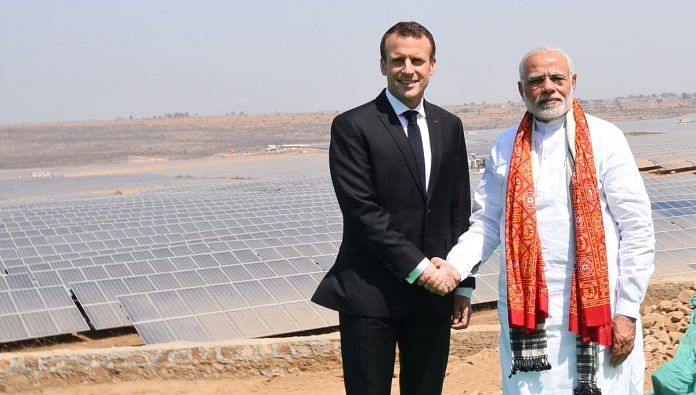While capacity is expanding rapidly, profit margins are shrinking, which could make it difficult for India to keep its promise of 100 GW solar power by 2022.
New Delhi: At the recently-concluded International Solar Alliance (ISA) summit in New Delhi, co-hosted by Prime Minister Narendra Modi and French President Emmanuel Macron, 62 countries pledged to consume more solar power, in order to deal with the challenges of climate change.
However, India’s own solar industry is under threat from gathering clouds – although capacity is being expanded aggressively, shrinking profit margins are becoming a huge challenge for the country to keep its position as a leader in solar power.
An emerging but flawed force
At the summit, Modi reiterated India’s pledge to generate 175 GW of electricity from renewable energy sources by 2022, out of which 100 GW will come from solar. India also announced a support of $1.4 billion to 15 countries to develop help to develop 27 solar projects sites.
A report by the Institute for Energy Economics and Financial Analysis (IEEFA) also said that India was becoming a force “at par” with China and Western Europe in its push towards renewable energy, thanks to falling tariffs, technological advances in the sector, and the availability of lower cost financing.
However, despite being set to achieve its target of installing 20 GW of solar capacity this fiscal, the 100 GW promise by 2022 looks a step too far, given that the integration of solar power into the electric grid has been slow because most of the solar projects are in remote locations, and transmission is a huge challenge, along with storage for use in the mainstream, coupled with the distribution companies fighting financial problems.
“Solar has a bright future in the off-grid market, but will face many challenges in the mainstream power supply, primarily due to non-availability of cost-effective storage, and discoms being under financial duress,” said Krishnadev C.S., director of Rashtraneeti.com, a website that tracks the clean energy market.
What’s eating into profits?
Tariffs for solar power have plunged due to aggressive bidding by industry players backed by foreign funds, who aren’t expecting high returns. From Rs 5.10/kWh in June 2015, the tariff plunged to Rs 2.44/kWh in May 2017, but has since stabilised to Rs 2.50/Kwh.
The cost of solar panels and the inability of state power distribution companies to purchase solar electricity has eaten into profits as well. In 2017, India added about 9.6 GW solar power capacity, with Telangana and Karnataka installing over 2 GW each. However, these two states accounted for approximately 50 per cent of all installations across the country. The forecast of total installations in 2018 has been reduced by 22 per cent year-on-year to 7.5 GW.
Clean energy market tracker Mercom India observed in a report: “The lower forecast reflects a smaller pipeline of projects scheduled for commissioning in 2018. Auction activity was not very robust in 2017, and though there was a surge in activity at the end of the year, most of the projects that were tendered are not likely to be commissioned until 2019.”
Problems aplenty back home
The productivity per employee in the domestic solar cell producing industry has declined, inventories have increased, and because the domestic industry is operating far below its installed capacity, there has been a significant loss in potential employment opportunities.
In January, this downward trend forced the Directorate General of Safeguards, Customs and Central Excise to recommend a 70 per cent safeguard duty on imported solar cells and modules from China and Malaysia for 200 days.
Also, the imposition of 5 per cent GST on solar panels from a zero tax regime has hurt the industry. Adding to that is the confusion on GST rates on other components.
One of the other major concerns is the slow-paced growth of the rooftop solar component, as there is no incentive for residential rooftop solar projects. The government has reduced the target for 2018 from 5,000 MW to only 1,000 MW. Hence, net metering, which allows users to sell surplus power to electricity utilities, should be made available so that the residential rooftop solar projects take off, said Krishnadev.
Andrew Hines, co-founder of Cleanmax Solar, a rooftop solar developing company, added: “In the National Capital Region, rooftop solar plants consistently underperform any projection which is based on historical data, because pollution affects the solar radiation received. In another plant, the situation will be very different. Broadly, we should expect plant performance to improve as the industry matures.”
The way forward
According to the IEEFA, one sensible strategy for India would be to export electricity to new markets in Nepal, Bhutan, Bangladesh, and potentially Sri Lanka and Myanmar. Such a strategy would accelerate system-demand growth and improve thermal power capacity utilisation, alleviating some of the ongoing stranded asset burdens that continue to erode returns in both the Indian power and banking sectors.
Moreover, IEEFA expects global renewable energy prices to continue to see at least 5-10 per cent annual deflation. Given this, it is entirely feasible that prices in India will fall below Rs 2.0/kWh in the next two to three years, barring self-defeating import duties on solar modules.



